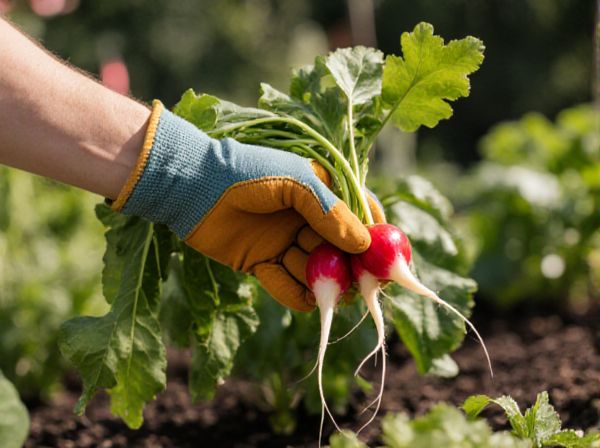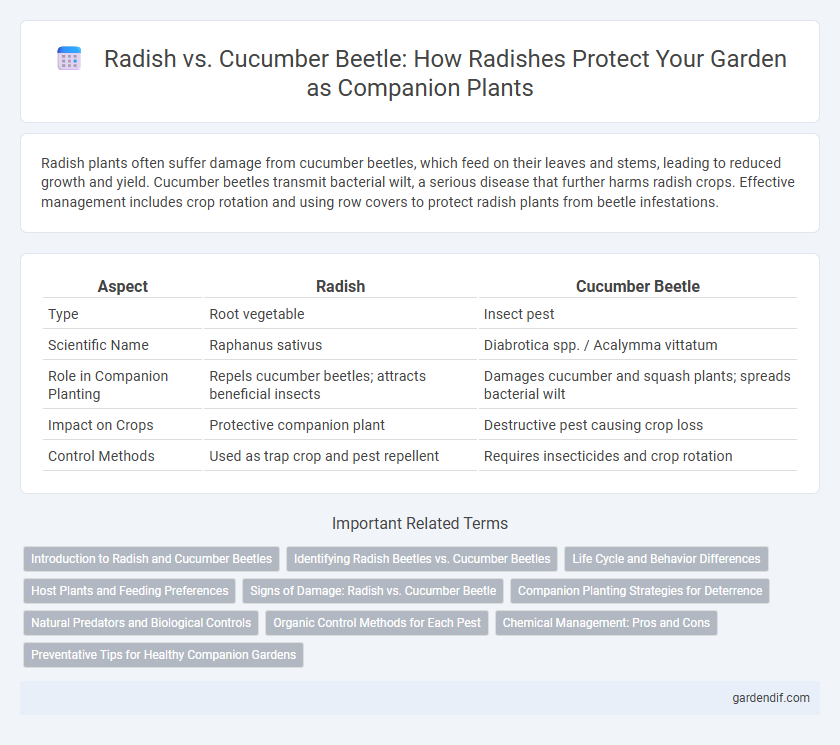
Radish vs cucumber beetle Illustration
Radish plants often suffer damage from cucumber beetles, which feed on their leaves and stems, leading to reduced growth and yield. Cucumber beetles transmit bacterial wilt, a serious disease that further harms radish crops. Effective management includes crop rotation and using row covers to protect radish plants from beetle infestations.
Table of Comparison
| Aspect | Radish | Cucumber Beetle |
|---|---|---|
| Type | Root vegetable | Insect pest |
| Scientific Name | Raphanus sativus | Diabrotica spp. / Acalymma vittatum |
| Role in Companion Planting | Repels cucumber beetles; attracts beneficial insects | Damages cucumber and squash plants; spreads bacterial wilt |
| Impact on Crops | Protective companion plant | Destructive pest causing crop loss |
| Control Methods | Used as trap crop and pest repellent | Requires insecticides and crop rotation |
Introduction to Radish and Cucumber Beetles
Radishes are fast-growing root vegetables valued for their peppery flavor and pest-repellent properties in companion planting. Cucumber beetles, which are notorious pests in vegetable gardens, target cucurbits and can transmit bacterial wilt disease. Understanding the biology and behavior of both radishes and cucumber beetles is essential for effective pest management and protecting crops.
Identifying Radish Beetles vs. Cucumber Beetles
Radish beetles, typically smaller and darker with a speckled or striped pattern, primarily target radish crops whereas cucumber beetles are usually yellow-green with distinct black spots or stripes, damaging cucumbers and related plants. Identifying radish beetles involves looking for a more rounded body and less vibrant coloration compared to the elongated, brightly patterned cucumber beetles. Accurate differentiation is essential for effective pest management and protecting specific garden plants.
Life Cycle and Behavior Differences
Radish and cucumber beetles exhibit distinct life cycles and behaviors influencing companion planting strategies. Radish beetles typically have multiple generations per year, with larvae feeding on root systems, causing significant damage underground. In contrast, cucumber beetles lay eggs near cucurbit plants, with larvae targeting roots, and adults feeding on leaves and flowers, displaying more surface-level plant interaction.
Host Plants and Feeding Preferences
Radish serves as a preferred host plant for cucumber beetles, attracting these pests due to its tender leaves and nutrient-rich composition. Cucumber beetles primarily feed on cucurbit plants such as cucumbers, melons, and squash, but their larvae also consume roots of radishes and related Brassicaceae species. Understanding the feeding preferences and host plant relationships of cucumber beetles helps in developing effective companion planting strategies to minimize crop damage.
Signs of Damage: Radish vs. Cucumber Beetle
Radish plants infested with cucumber beetles exhibit distinct signs of damage, including irregular holes and skeletonized leaves caused by adult feeding. Seedlings often suffer from wilting and stunted growth as beetles chew on stems and roots, undermining plant development. Signs such as yellowing foliage and black fecal spots on leaves further indicate cucumber beetle activity on radish crops.
Companion Planting Strategies for Deterrence
Radishes act as an effective companion plant by attracting cucumber beetles away from cucumbers, disrupting their breeding cycle and reducing crop damage. Planting radishes around cucumber beds creates a natural barrier, leveraging their strong scent to confuse and repel beetles. Rotating crops and interspersing radishes with cucumbers enhances pest control, promoting healthier growth through strategic companion planting.
Natural Predators and Biological Controls
Radish plants attract natural predators such as lady beetles and parasitic wasps that target cucumber beetle larvae, effectively reducing their population. Biological controls like neem oil and Bacillus thuringiensis (Bt) treatments disrupt cucumber beetle development without harming beneficial insects. Incorporating radish as a companion plant supports an integrated pest management strategy by enhancing the environment for these valuable predators and biocontrol agents.
Organic Control Methods for Each Pest
Radish can deter cucumber beetles through natural repellents found in its foliage, making it an effective companion plant in organic gardens. For organic control of cucumber beetles, methods include neem oil application, row covers to prevent beetle access, and introducing beneficial insects like ladybugs. Radish pests can be managed using insecticidal soaps, crop rotation, and encouraging predatory insects, maintaining a balanced ecosystem without synthetic chemicals.
Chemical Management: Pros and Cons
Radish acts as a natural trap crop for cucumber beetles by emitting specific chemical compounds like glucosinolates that attract these pests, thereby reducing their population on cucumbers. However, reliance on radish for chemical management may lead to inconsistent results due to varying glucosinolate concentrations influenced by environmental factors. In contrast, chemical insecticides targeting cucumber beetles offer immediate pest suppression but risk disrupting beneficial insect populations and promoting pesticide resistance.
Preventative Tips for Healthy Companion Gardens
Radish plants serve as an effective companion crop for deterring cucumber beetles by emitting natural compounds that repel these pests, reducing the risk of infestations in cucumber crops. Interplanting radishes near cucumbers can disrupt beetle behavior and protect the vulnerable plants from damage caused by beetle feeding and disease transmission. Regularly monitoring garden health, maintaining soil fertility, and employing cultural practices like crop rotation further enhance resistance against cucumber beetle populations in companion garden settings.
Radish vs cucumber beetle Infographic

 gardendif.com
gardendif.com